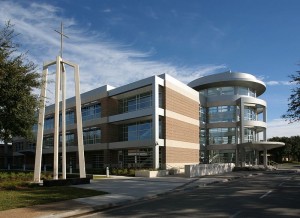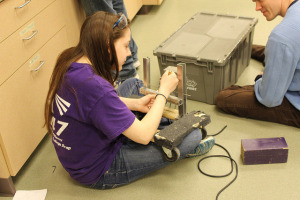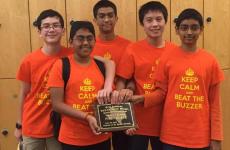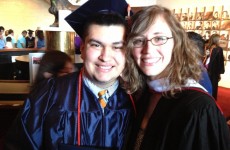As we discussed in a recent article on Marie Curie, women are severely underrepresented in STEM fields. The prevailing stereotypes – and in some cases, the workplace cultures within STEM – reinforce the idea that STEM is a masculine pursuit.
But of course, there’s absolutely no reason this should be so. Women and men are equally capable of doing well in science, math, and engineering. In light of our culture’s attitudes about women in STEM, it’s important to remind young girls of this and, if they are interested in these areas, encourage them to pursue their dreams.
One Houston school which excels at this is St. Agnes Academy. This Catholic all-girls school in Sharpstown has strong programs in mathematics and science. AP Computer Science is offered, and in the fall of 2015, an intro-level computer science elective will be introduced as well. St. Agnes also gives students the opportunity to learn about robotics by participating in the Spectrum 3847 robotics team, which represents both St. Agnes and Strake Jesuit.
Like most elite preparatory schools, St. Agnes offers a math curriculum that goes up through AP Calculus BC. But St. Agnes’ calculus teacher, Denise Stasio, does more than just mathematics – she also teaches girls how to code.
Mrs. Stasio, who learned to love programming in graduate school, has always incorporated a little bit of code into her math classes. She teaches her algebra students the basics of programming for their graphing calculators, and encourages them to write calculator applications on their own if they want to. And this year, as the co-organizer of St. Agnes’ Hour of Code event, she was instrumental in bringing the experience of programming to the entire school.
The Hour of Code, a worldwide event sponsored by Code.org for Computer Science Education Week, was designed to make programming accessible to students regardless of their level of experience. At St. Agnes, the event was made available to all students, and a significant number participated.
Starting next year, Mrs. Stasio will be teaching St. Agnes’ new computer science elective. The class will be geared toward sophomores and juniors; the only prerequisite will be geometry, meaning that more than half of the student body will be eligible to take it. While the curriculum is not yet set in stone, it will probably center on Python, the simplest programming language to use and an ideal choice for beginners. She plans to structure the course around in-class coding time, so that students can share the joy of success as they learn how to create increasingly complex programs.
Mrs. Stasio puts a premium on the sense of accomplishment her students gain from math and computer science. In her words, “I want each girl to experience the fun and satisfaction of being successful in thinking and solving problems before she moves on to college, and life.”
The new computer science elective will help encourage students to pursue more complicated problem-solving in AP Computer Science A, which is offered jointly with Strake Jesuit. In this course, students learn the Java programming language and use it to write code on par with what would be expected in an intro-level college computer science class.
St. Agnes is also notable for its rich and varied science curriculum. In addition to the subject areas taught in most college preparatory curricula – biology, chemistry, and physics – the school offers courses in anatomy, physiology, genetics, geology, oceanography, astronomy, and forensic science. These classes can spark early interest and lay the foundations for a wide range of careers in research science, medicine, and even petroleum engineering.
St. Agnes also offers STEM opportunities outside the classroom, particularly through the Spectrum 3847 robotics team, which jointly represents St. Agnes and Strake Jesuit. In the words of its mission statement, students on the team “work together to spread engineering to others, build robots, and have fun.”
Under the guidance of coach Allen Gregory, Spectrum competes in FIRST, a robotics competition in which students design and build a robot in just 45 days. As of this writing, the 2015 FIRST competition is underway, and Spectrum team members are hard at work on their entry for the “Recycle Rush” game that comprises this year’s FIRST event. Robots built for the game must be able to move with precision to pick up and place objects representing litter and boxes of recyclables, and they must be able to perform these tasks autonomously as well as under students’ control.
While Coach Gregory and other adults may offer limited advice, students are responsible for designing, building, and programming the robots. (To see this process in action, you can check out the team’s blog, where they document their progress throughout the FIRST season.) The successful completion of a robot requires students with many different skill sets to work together. Different subgroups within the team focus on design (using CAD), mechanics, and programming.
In addition to the annual FIRST competition, Spectrum members compete in the BEST robotics competition and participate in community outreach to help more students engage with STEM. Outreach events include Canstruction, a project which combines engineering and hunger relief, and Spectacular, a free summer robotics course for the Boys and Girls Club of Spring Branch.
Another notable outreach program in which Spectrum participates is “Be the Change.” Each year, St. Agnes hosts a three-week “Be the Change” program for rising seventh- and eighth-grade girls from inner-city Catholic schools. The program is designed to help disadvantaged students work towards and prepare for a Catholic high school education. Among the program’s many features are hands-on science labs, some of them taught by Spectrum students. Through “Be the Change,” St. Agnes students can work to advance STEM education for girls in the broader Houston community.
Updated 1/19/2015.


















2 Comments